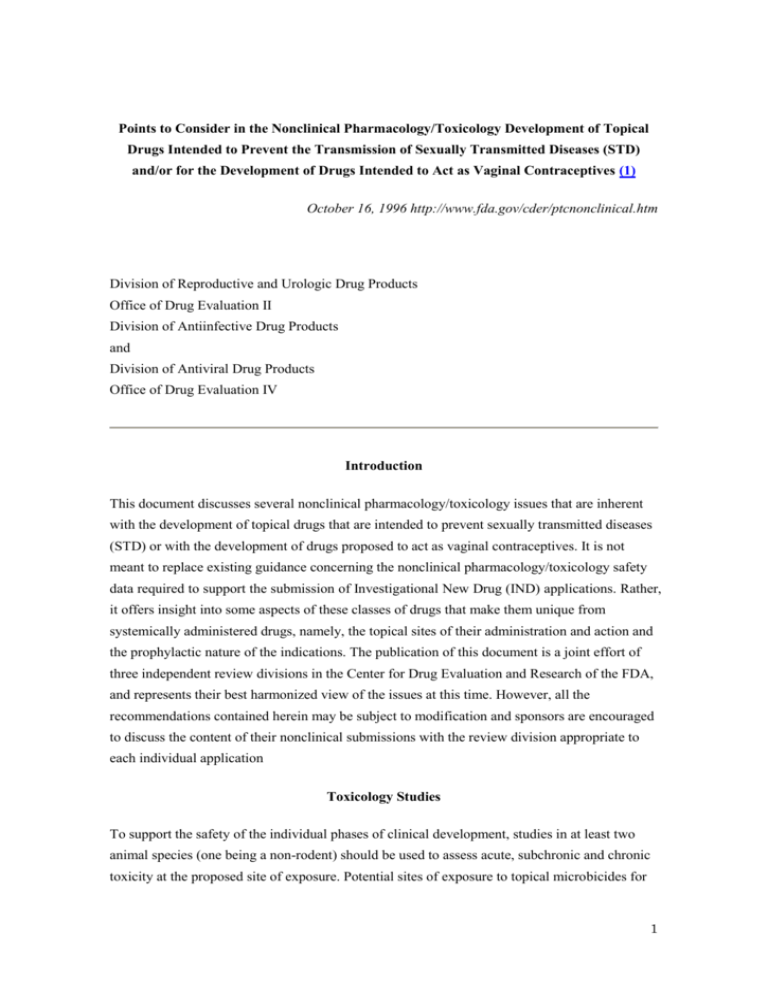Points to Consider in the Nonclinical Pharmacology/Toxicology
advertisement

Points to Consider in the Nonclinical Pharmacology/Toxicology Development of Topical Drugs Intended to Prevent the Transmission of Sexually Transmitted Diseases (STD) and/or for the Development of Drugs Intended to Act as Vaginal Contraceptives (1) October 16, 1996 http://www.fda.gov/cder/ptcnonclinical.htm Division of Reproductive and Urologic Drug Products Office of Drug Evaluation II Division of Antiinfective Drug Products and Division of Antiviral Drug Products Office of Drug Evaluation IV Introduction This document discusses several nonclinical pharmacology/toxicology issues that are inherent with the development of topical drugs that are intended to prevent sexually transmitted diseases (STD) or with the development of drugs proposed to act as vaginal contraceptives. It is not meant to replace existing guidance concerning the nonclinical pharmacology/toxicology safety data required to support the submission of Investigational New Drug (IND) applications. Rather, it offers insight into some aspects of these classes of drugs that make them unique from systemically administered drugs, namely, the topical sites of their administration and action and the prophylactic nature of the indications. The publication of this document is a joint effort of three independent review divisions in the Center for Drug Evaluation and Research of the FDA, and represents their best harmonized view of the issues at this time. However, all the recommendations contained herein may be subject to modification and sponsors are encouraged to discuss the content of their nonclinical submissions with the review division appropriate to each individual application Toxicology Studies To support the safety of the individual phases of clinical development, studies in at least two animal species (one being a non-rodent) should be used to assess acute, subchronic and chronic toxicity at the proposed site of exposure. Potential sites of exposure to topical microbicides for 1 the prevention of STDs include vaginal, cervical, penile, oral and rectal mucosal areas. For the purpose of this document, contraceptives are considered to expose vaginal and penile tissue. All toxicology studies should use at least three dose levels of the drug and an appropriate control, with the high dose showing frank toxicity (it is understood that there may be limits to the ability to achieve a toxic dose), and the low dose showing little or no toxicity. With the exception of the varying concentrations of the active product, the drug to be applied should be in its final formulation and the study duration should be equal to, or longer than, the proposed duration of treatment in the clinical trial. However, if in an early trial, the duration of treatment is for less than two weeks, a nonclinical study duration of two weeks should generally be used. All nonclinical studies carried out to assess safety of a drug should be performed according to Good Laboratory Practices as outlined in 21 CFR. 58. Sponsors should consult with the FDA reviewing pharmacologist concerning approaches and protocols regarding these issues. Because the topical microbicides are intended for intermittent use during periods in which the individual will be at risk of contracting a STD and contraceptives are intended for intermittent use over long periods of reproductive competence, they are, for regulatory purposes, considered to be chronically administered drugs. Thus, in the latter stages of clinical development, six month studies in a rodent and one year toxicity studies in a non-rodent will be necessary to support phase 2/3 human trials. Carcinogenicity studies in rats and mice should be performed during the late stages of the drug development program. Pharmacokinetic/Toxicokinetic Studies During the conduct of subchronic and chronic toxicity studies, concurrent pharmacokinetic/toxicokinetic analyses should be performed to evaluate the drug's ADME (absorption, disposition, metabolism and excretion) profile and to determine if the drug is systemically absorbed. Appropriate analytical methodology should be established as early as possible to provide for precise, consistent and reliable pharmacokinetic data. Major pharmacokinetic endpoints such as maximum plasma concentration, time to maximum plasma concentration, area under the concentration time curve, volume of distribution, bioavailability and clearance should be determined. To better assess margins of safety, the animal pharmacokinetic data should be compared with data in humans. For instance, a drug might be absorbed in humans and the vaginal route of delivery in animals cannot achieve much higher systemic drug levels than those seen in humans. In that case, a one to three-month toxicology study in one species, with parenteral or oral administration of the drug, may be requested to produce sufficiently high blood levels to identify all potential toxicities. If the drug is absorbed, histopathology should be carried out on the full spectrum of organs and tissues. 2 Irritation The likelihood of drug-induced irritation (adverse reactions such as inflammatory responses) to drug exposed tissues should be evaluated in animals at both the macroscopic and microscopic levels. Vaginal irritation tests should be carried out in rabbits with daily applications for ten days. If rabbits are adequately tested by the vaginal route for adverse effects in toxicology studies, no separate vaginal irritation study is required. If the drug is found to be irritating to mucosal tissues and the sponsor decides to pursue further development, additional pharmacokinetics should be carried out to compare the extent of penetration of the drug across the inflamed tissue with that occurring in intact tissue. These data will help to determine whether the absorption kinetics of the drug is facilitated when the mucosa is compromised. Hypersensitivity and Photosensitivity If appropriate, the potential to produce hypersensitivity and photosensitivity of the drug should be evaluated. Examples of animal models and protocols for tests related to these toxicities can be found in references such as Marzulli and Maibach's "Dermatotoxicology" or Burleson, Dean and Munson's "Methods in Immunotoxicology." Genotoxicity A standard battery of tests should be carried out to evaluate all new molecular entities for the potential to induce genotoxic effects. A drug should be evaluated for potential genetic toxicity prior to the submission of the IND. The standard battery consists of the three following tests: 1) A gene mutation test in bacteria; 2) An in vitro mouse lymphoma tk assay or a mammalian cell in vitro cytogenetic test for chromosomal aberrations; 3) An in vivo test for chromosomal damage to rodent bone marrow cells or a mouse micronucleus test. If the three tests chosen indicate that the drug is devoid of genetic toxicity, no additional studies need to be carried out. If one or more of the battery is positive, the sponsor will be expected to carry out additional genotoxicity tests in consultation with the appropriate review division. For 3 detailed information regarding genotoxicity, sponsors should refer to the document entitled "Guidance on Specific Aspects of Regulatory Genotoxicity Tests for Pharmaceuticals." Copies of the Guideline are available from the CDER Consumer Affairs Branch, HFD-210, Center for Drug Evaluation and Research, 5600 Fishers Lane, Rockville, MD 20857. Reproductive Toxicology Reproductive toxicology studies should be carried out to explore the possible effects of the drug on fertility and reproductive performance. Additional studies should be performed to examine whether the drug is teratogenic or has an affect on perinatal/postnatal development. Studies designed to assess the teratogenic potential should be carried out in two species, usually in rats and rabbits. It is expected that reproductive toxicology studies will be completed prior to Phase 2/3 trials. For detailed information regarding reproductive toxicology, sponsors should refer to the document entitled, "Guideline for Industry, Detection of Toxicity to Reproduction for Medicinal Products." Copies of the Guideline are available from the CDER Consumer Affairs Branch, HFD-210, Center for Drug Evaluation and Research, 5600 Fishers Lane, Rockville, MD 20857. Carcinogenicity Carcinogenicity information is usually obtained during the final phase of the clinical development program. For a vaginal contraceptive, carcinogenicity tests in rats and mice should be submitted with the NDA. For a microbicide, carcinogenicity studies are also required, but the expected date of completion of the studies in relation to the filing of the NDA may vary. The drug should be administered for two years and the doses used should be chosen according to the principles outlined in the document entitled, "Guideline for Industry, Dose Selection for Carcinogenicity Studies of Pharmaceuticals." Copies of the Guideline are available from the CDER Consumer Affairs Branch, HFD-210, Center for Drug Evaluation and Research, 5600 Fishers Lane, Rockville, MD 20857. Sponsors should consult with the appropriate reviewing division for the current position and strategic approaches to these issues. Currently, it is recommended that sponsors request that the Executive Committee of the Carcinogenicity Assessment Committee of the Center for Drug Evaluation and Research review the protocols for the carcinogenicity studies prior to their initiation and concur on their content. Already Marketed Drugs On 2/3/95, a notice of proposed rulemaking from the Food and Drug Administration entitled, "Vaginal Contraceptive Drug Products for Over-the-Counter Human Use" appeared in the 4 Federal Register (Vol. 60, No. 23, pp, 6892-6903). The proposed rule stated that manufacturers of over-the-counter (OTC) vaginal contraceptive drug products would be required to obtain approved applications for marketing of their products. The agency took this action because the effectiveness of these products is dependent upon the final formulation. Therefore, each product must be tested in appropriate clinical trials under actual conditions of use. The proposed rulemaking does not affect the current marketing status of OTC vaginal contraceptives. However, on the effective date of a final regulation, an OTC vaginal contraceptive drug product that is not the subject of an approved application would be regarded as a new drug and be subjected to regulatory action regardless of its status prior to the publishing of the final regulation. The agency has determined that nonoxynol 9 and octoxynol 9 would be appropriate ingredients for an approved application and has concluded that although nonoxynol 9 and octoxynol 9 kill sperm in vitro and in vivo, the spermicidal activity and resulting effectiveness of these contraceptive active ingredients cannot be considered separately from a product's vehicle. These active ingredients lose some of their effectiveness in humans when the spermicide in final formulation is diluted by various amounts of genital secretions during coitus. Thus, clinical studies are necessary to establish effectiveness of the spermicide's final formulation when used in humans. However, applications for currently marketed OTC products containing these ingredients require no additional nonclinical data, but, instead, may refer to (1) the recommendations of the Advisory Review Panel on OTC Contraceptives and Other Vaginal Drug Products that appeared in an advanced notice of proposed rulemaking in the Federal Register (12/12/1980, Vol. 45, No.241, pp 82014-82049), entitled, "Vaginal Contraceptive Drug Products for Over-the-Counter Human Use; Establishment of a Monograph; Proposed Rulemaking," and (2) the history of use of approved drug products containing nonoxynol 9. The quest to identify safe and effective products for the prevention of HIV and other STDs is a high priority public health concern. Sponsors are strongly encouraged to evaluate OTC contraceptive products towards this use. However it should be recognized that studies designed to assess the safety and effectiveness of a formulated drug to prevent pregnancy and to prevent the transmission of an STD may be different. Manufacturers wishing to develop a formulation towards one or the other are encouraged to enter into a dialog with the appropriate reviewing divisions concerning the content of their applications. References 5 Dermatotoxicology. Ed., Marzulli, F.N. and H.I. Maibach. New York: Hemisphere Publishing, 1991. Methods in Immunotoxicology. Ed., Burleson, G.R., J.H. Dean and A.E. Munson. New York: Wiley-Liss, Inc., 1995. (1) 1. This document is an informal communication under 21 CFR 10.90 (b) (9) that represents the best judgement of the Divisions of Reproductive and Urologic Drug Products, the Division of Antiinfective Drug Products and the Division of Antiviral Drug Products at this time. This document does not necessarily represent the formal position of the Center for Drug Evaluation and Research or the Food and Drug Administration, and it does not bind or otherwise obligate the Center or Agency to the views expressed. 6







